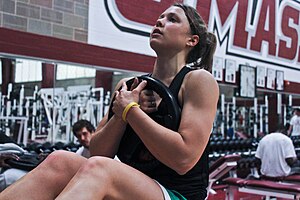Sit-up: Difference between revisions
m Reverted edits by 42.98.241.168 (talk) to last version by Traintogain |
|||
| Line 8: | Line 8: | ||
[[Image:Crunches.jpg|thumb|right|300px|Using a weight to intensify sit-up]] |
[[Image:Crunches.jpg|thumb|right|300px|Using a weight to intensify sit-up]] |
||
==== |
==Form== |
||
It begins with lying with the back on the floor, typically with the arms across the chest or hands behind the head and the knees bent in an attempt to reduce stress on the back muscles and spine, and then elevating both the upper and lower [[vertebrae]] from the floor until everything superior to the [[buttocks]] is not touching the ground. Some argue that situps can be dangerous due to high compressive lumbar load<ref>{{cite journal |first1=Stuart M. |last1=McGill |title=Stability: from biomechanical concept to chiropractic practice |journal=Journal of the Canadian Chiropractic Association |volume=43 |issue=2 |pages= |
It begins with lying with the back on the floor, typically with the arms across the chest or hands behind the head and the knees bent in an attempt to reduce stress on the back muscles and spine, and then elevating both the upper and lower [[vertebrae]] from the floor until everything superior to the [[buttocks]] is not touching the ground. Some argue that situps can be dangerous due to high compressive lumbar load<ref>{{cite journal |first1=Stuart M. |last1=McGill |title=Stability: from biomechanical concept to chiropractic practice |journal=Journal of the Canadian Chiropractic Association |volume=43 |issue=2 |pages=75–88 |date=June 1999 |pmc=2485366 |url=http://www.ncbi.nlm.nih.gov/pmc/articles/PMC2485366/ |pmid=}}</ref> and may be replaced with the [[crunch (exercise)|crunch]] in exercise programs.<ref>{{cite book|last=McGill|first=Stuart|title=Low Back Disorders: Evidence-based Prevention and Rehabilitation|publisher=Human Kinetics Publishers|isbn=978-0-7360-6692-1}}{{Page needed|date=November 2010}}</ref> |
||
Strength exercises such as sit-ups and [[Press-up|push-up]]s do not cause the [[spot reduction]] of fat (abdominal muscular hypertrophy). Gaining a "[[Rectus abdominis muscle|six pack]]" requires both abdominal [[muscle hypertrophy]] training and fat loss over the abdomen—which can only be done by losing fat from the body as a whole.<ref name="Kravitz">{{cite journal |first1=Frank I. |last1=Katch |first2=P. M. |last2=Clarkson |first3=W. |last3=Kroll |first4=T. |last4=McBride |first5=A. |last5=Wilcox |date=September 1984 |title=Effects of sit up exercise training on adipose cell size and adiposity |journal=Research Quarterly for Exercise and Sport |volume=55 |issue=3 |pages=242–47}}</ref> |
|||
===Variations=== |
|||
The movement can be made easier by placing the arms further down away from the head. Typical variations to achieve this include crossing the arms to place the palms on the front of the shoulders<ref>{{cite web|title=Sit-up (arms crossed)|url=http://exrx.net/WeightExercises/RectusAbdominis/BWSitUpX.html|accessdate=20 November 2014}}</ref> and extending the arms down to the sides with palms on the floor.<ref>{{cite web|title=Sit-up (arms down)|url=http://exrx.net/WeightExercises/RectusAbdominis/BWSitUpAD.html|accessdate=20 November 2014}}</ref> The 'arms on shoulders' variation is also used to make the incline sit-up<ref>{{cite web|title=Incline Sit-up (arms crossed)|url=http://exrx.net/WeightExercises/RectusAbdominis/BWInclineSitUpX.html|accessdate=20 November 2014}}</ref> easier. |
|||
More intense movement is achieved by doing weighted sit-ups,<ref>{{cite web|title=Weighted Sit-up|url=http://www.exrx.net/WeightExercises/RectusAbdominis/WtSitUp.html|accessdate=20 November 2014}}</ref> incline sit-ups with arms behind neck<ref>{{cite web|title=Incline Sit-up|url=http://exrx.net/WeightExercises/RectusAbdominis/BWInclineSitUp.html|accessdate=20 November 2014}}</ref> and even harder one by doing the weighted incline sit-up.<ref>{{cite web|title=Weighted Incline Sit-up (arms crossed)|url=http://exrx.net/WeightExercises/RectusAbdominis/WtInclineSitUpX.html|accessdate=20 November 2014}}</ref> |
|||
==References== |
==References== |
||
Revision as of 02:42, 7 December 2014
It has been suggested that Sit ups punishment be merged into this article. (Discuss) Proposed since October 2014. |

The sit-up is an abdominal strength training exercise commonly performed to strengthen the abdominal muscles. It is similar to a crunch (crunches target the rectus abdominus and also work the obliques), but sit-ups have a fuller range of motion and condition additional muscles. Sit-ups target the hip flexors, rectus abdominus and also work the iliopsoas, tensor fasciae latae, rectus femoris, sartorius, and, to a very small degree, the obliques.

Form
It begins with lying with the back on the floor, typically with the arms across the chest or hands behind the head and the knees bent in an attempt to reduce stress on the back muscles and spine, and then elevating both the upper and lower vertebrae from the floor until everything superior to the buttocks is not touching the ground. Some argue that situps can be dangerous due to high compressive lumbar load[1] and may be replaced with the crunch in exercise programs.[2]
Strength exercises such as sit-ups and push-ups do not cause the spot reduction of fat (abdominal muscular hypertrophy). Gaining a "six pack" requires both abdominal muscle hypertrophy training and fat loss over the abdomen—which can only be done by losing fat from the body as a whole.[3]
Variations
The movement can be made easier by placing the arms further down away from the head. Typical variations to achieve this include crossing the arms to place the palms on the front of the shoulders[4] and extending the arms down to the sides with palms on the floor.[5] The 'arms on shoulders' variation is also used to make the incline sit-up[6] easier.
More intense movement is achieved by doing weighted sit-ups,[7] incline sit-ups with arms behind neck[8] and even harder one by doing the weighted incline sit-up.[9]
References
- ^ McGill, Stuart M. (June 1999). "Stability: from biomechanical concept to chiropractic practice". Journal of the Canadian Chiropractic Association. 43 (2): 75–88. PMC 2485366.
- ^ McGill, Stuart. Low Back Disorders: Evidence-based Prevention and Rehabilitation. Human Kinetics Publishers. ISBN 978-0-7360-6692-1.[page needed]
- ^ Katch, Frank I.; Clarkson, P. M.; Kroll, W.; McBride, T.; Wilcox, A. (September 1984). "Effects of sit up exercise training on adipose cell size and adiposity". Research Quarterly for Exercise and Sport. 55 (3): 242–47.
- ^ "Sit-up (arms crossed)". Retrieved 20 November 2014.
- ^ "Sit-up (arms down)". Retrieved 20 November 2014.
- ^ "Incline Sit-up (arms crossed)". Retrieved 20 November 2014.
- ^ "Weighted Sit-up". Retrieved 20 November 2014.
- ^ "Incline Sit-up". Retrieved 20 November 2014.
- ^ "Weighted Incline Sit-up (arms crossed)". Retrieved 20 November 2014.
